The Return of the Lawnmower Battery Surgeon
Tagged:CatBlogging
/
Physics
/
ϜΤΦ
A couple years having passed since the last cell transplant, our lawnmower is once again in need of battery surgery.
The Venerable Black & Decker SPCM1936
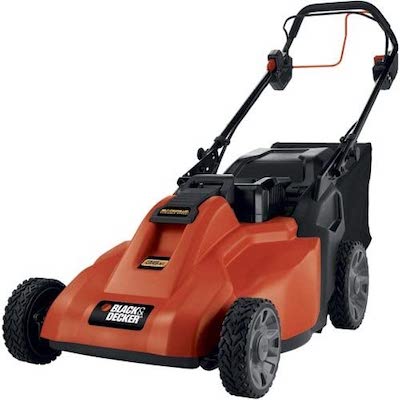 Once again, we were needed in our capacity as lawn mower battery surgeon, by our only
patient, the venerable Black & Decker SPCM1936
shown here. While a fine machine even at 13 years of age,
batteries remain a consumable: its battery is old & tired, only sustaining about 10min
of mowing at a time. Replacement batteries are, alas, no longer manufactured.
But rather than buy a new lawn mower, we bought replacement cells to transplant into the
battery.
Once again, we were needed in our capacity as lawn mower battery surgeon, by our only
patient, the venerable Black & Decker SPCM1936
shown here. While a fine machine even at 13 years of age,
batteries remain a consumable: its battery is old & tired, only sustaining about 10min
of mowing at a time. Replacement batteries are, alas, no longer manufactured.
But rather than buy a new lawn mower, we bought replacement cells to transplant into the
battery.
Again.
We did this almost exactly 2 years ago on 2022-Jun-24 [1], following the advice of numerous YouTube sages. It worked fine, until now. I would have preferred to see about 5 years of life in the battery, as we originally got, rather than just 2 years. Perhaps the replacement cells were not as robust, or perhaps I’ve been mowing more, or… I dunno. I just want a working lawn mower.
The Surgery
As always, I approach practical matters with fear and trembling, showing no small amount of respect to the trickster deities. As I said last time:
I figured with a PhD in physics I should maybe, just barely, be able to figure out how to wire 3 cells in series without shocking myself by touching battery terminals in some inappropriate way. (Then again, I was a theoretical physicist, so my lab skills may reasonably be questioned. I’m not as bad as Pauli – the second Pauli exclusion principle is: “a functioning device and Wolfgang Pauli may not occupy the same room” – but then again I wasn’t as good a theoretical physicist as he was, either.)
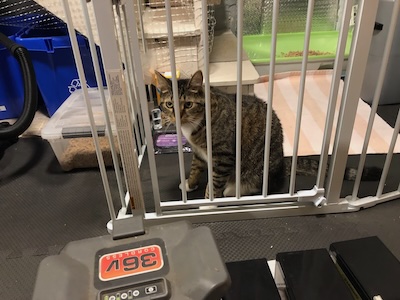 Our first step was to set up a small workspace in the basement. We were, of course,
immediately joined by a cat, torn between his desire to supervise and his general
curiosity. Here’s the Assistant Weekend Publisher, looking out from Cat Jail, which is
there to discourage exploration of dusty and dirty basement corners in which might lurk
dangers sharp, poisonous, or otherwise unfit for cats. (Alas, I missed an earlier shot
where he was reaching through the bars, hoping to scatter all my Torx driver heads under
various cabinets. Fortunately, Cat Jail was adequate to deter him in this effort to “help.”)
Our first step was to set up a small workspace in the basement. We were, of course,
immediately joined by a cat, torn between his desire to supervise and his general
curiosity. Here’s the Assistant Weekend Publisher, looking out from Cat Jail, which is
there to discourage exploration of dusty and dirty basement corners in which might lurk
dangers sharp, poisonous, or otherwise unfit for cats. (Alas, I missed an earlier shot
where he was reaching through the bars, hoping to scatter all my Torx driver heads under
various cabinets. Fortunately, Cat Jail was adequate to deter him in this effort to “help.”)
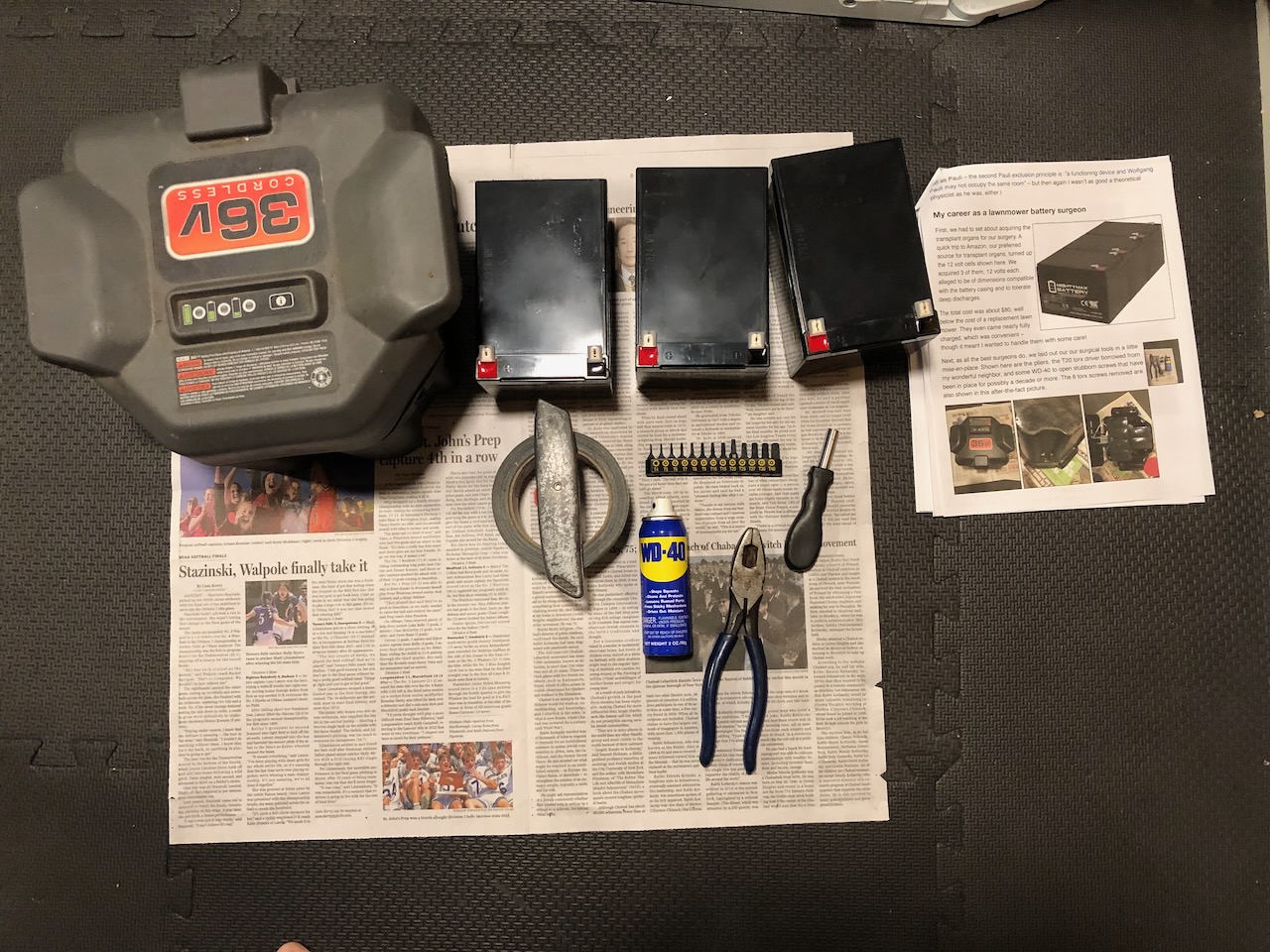 Next, we created our little mise en place, shown here:
Next, we created our little mise en place, shown here:
- In the upper left, of course, is our patient etherized upon our table. This is not the same battery we fixed 2 years ago, but another factory original. (We had two. This one is also defunct.) I decided to fix this one, since the previously fixed one at least had a little performance left in it. I wanted to avoid the situation in which some mishap left me with absolutely no semi-working battery.
- Top center are the 3 replacement organs, 12V sealed batteries for which there are many equivalent vendors. Note the red terminal, colored to ensure we don’t install it backwards! (We might, you know, have done that.)
- The surgical tools include Torx drivers (T20 is the one you want), some pliers and WD-40 to move recalcitrant parts, and duct tape. Because… duct tape.
- Finally, in the upper left is a printout of our escapades in battery surgery from 2 years ago, to remind us where the various internal organs are located.
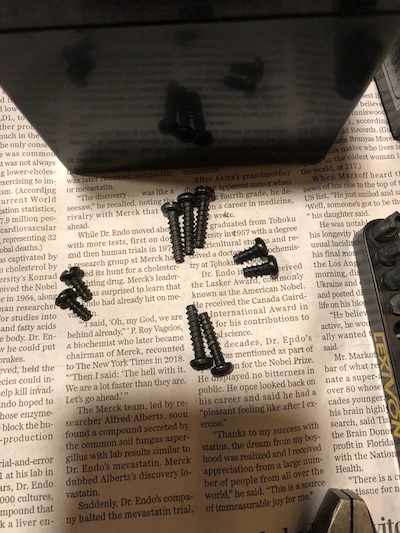 To quote Sergeant Oddball in the 1970 movie Kelly’s Heroes (brilliantly portrayed by Donald Sutherland),
who had his mechanic modify his WWII tank to have more speeds in reverse gear than in forward gear:
To quote Sergeant Oddball in the 1970 movie Kelly’s Heroes (brilliantly portrayed by Donald Sutherland),
who had his mechanic modify his WWII tank to have more speeds in reverse gear than in forward gear:
Oddball: These engines are the fastest in any tanks in the European Theater of Operations, forwards or backwards. You see, man, we like to feel we can get out of trouble, quicker than we got into it.
And so it is here: having removed the screws, I want to remember how to put them back. So here they are carefully arranged to tell me if they go on the front, back, or sides. Note the screws are of different lengths and thus not equivalent, so this matters.
(Yes, I really do have to do this. Ask me how I know.)
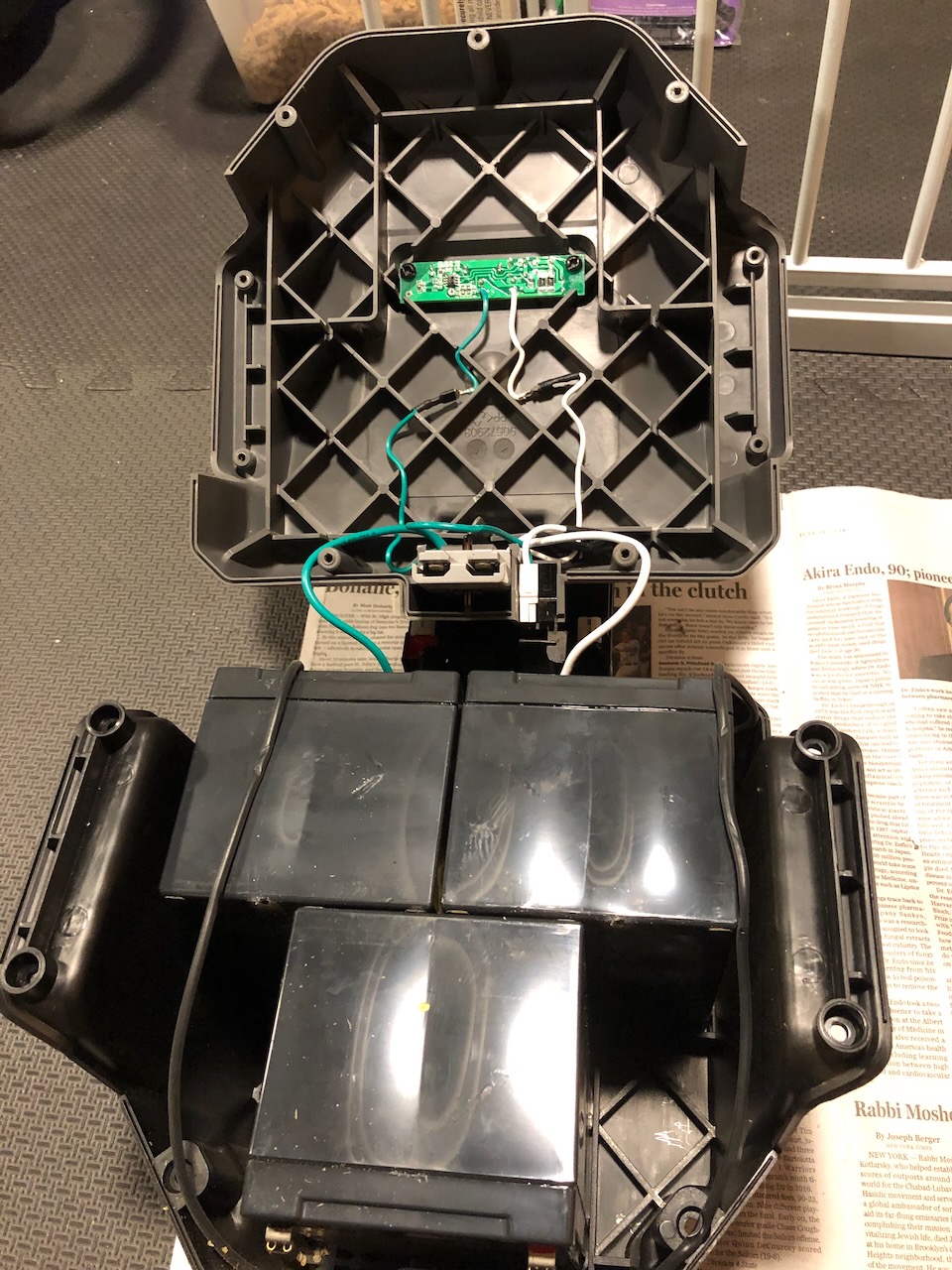 Here’s the scene when we have removed the screws on the bottom, carefully rotated the
battery right-side up again, and popped the top. The top is resting temporarily on one of
the new cells, so we can see everything in one glance.
Here’s the scene when we have removed the screws on the bottom, carefully rotated the
battery right-side up again, and popped the top. The top is resting temporarily on one of
the new cells, so we can see everything in one glance.
The main point here is that the old cells are obviously swollen, explaining why the battery is dead. Fortunately, they are not leaking, so disposal will be a (later) problem for our town’s waste folk, not for my immediate basement cleanup.
Also worth noting are the wire colors: 2 black wires in the front, which connect to the outside terminals in the back. Then the inside terminals in the back connect to a green wire and a white wire. Best not mess that up!
The tiny PC board at the top is to drive some LEDs that are (sorta) charge indicators. Not very accurate, but ok… ish. See below, where we use it as a continuity test.
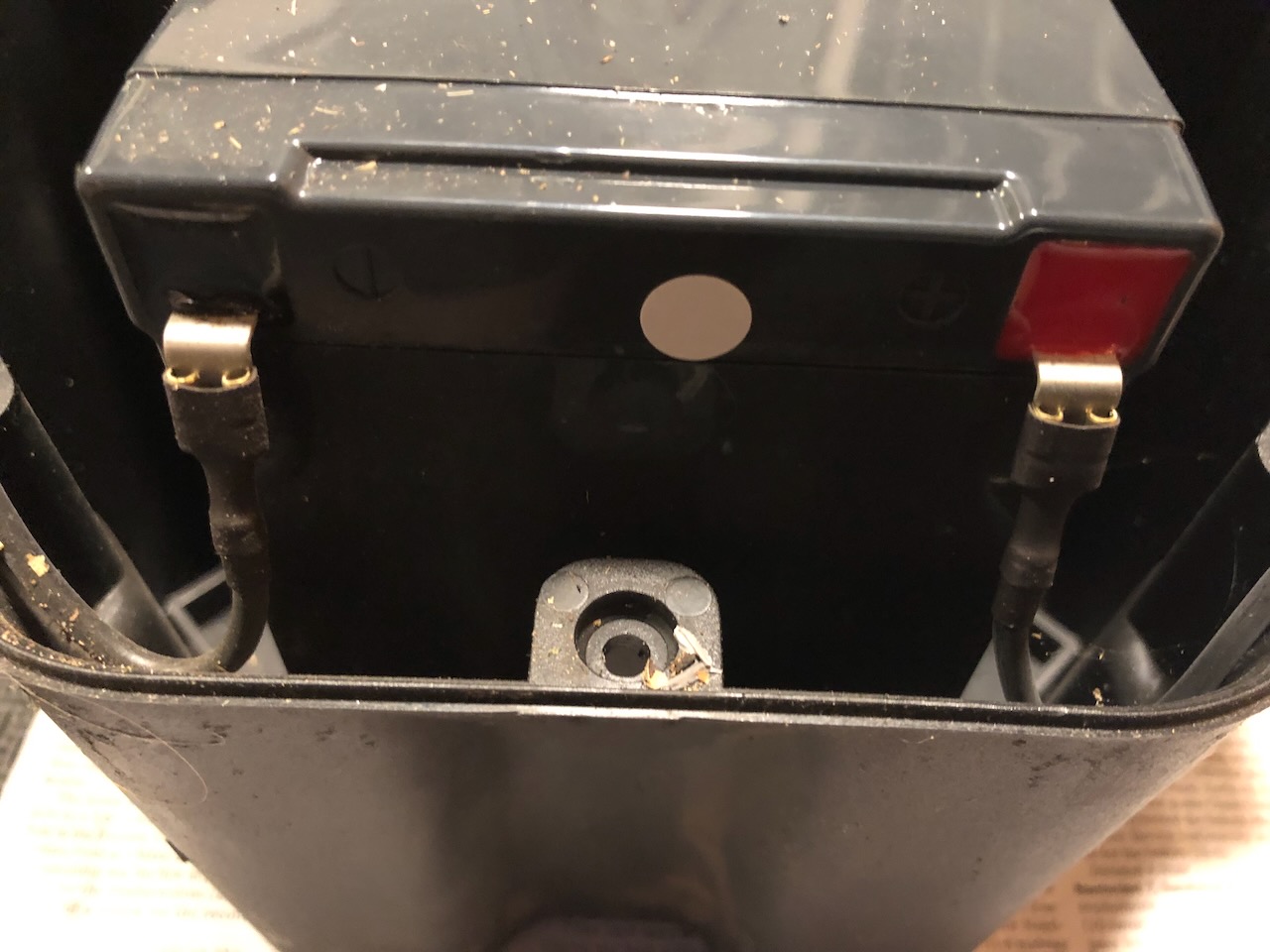
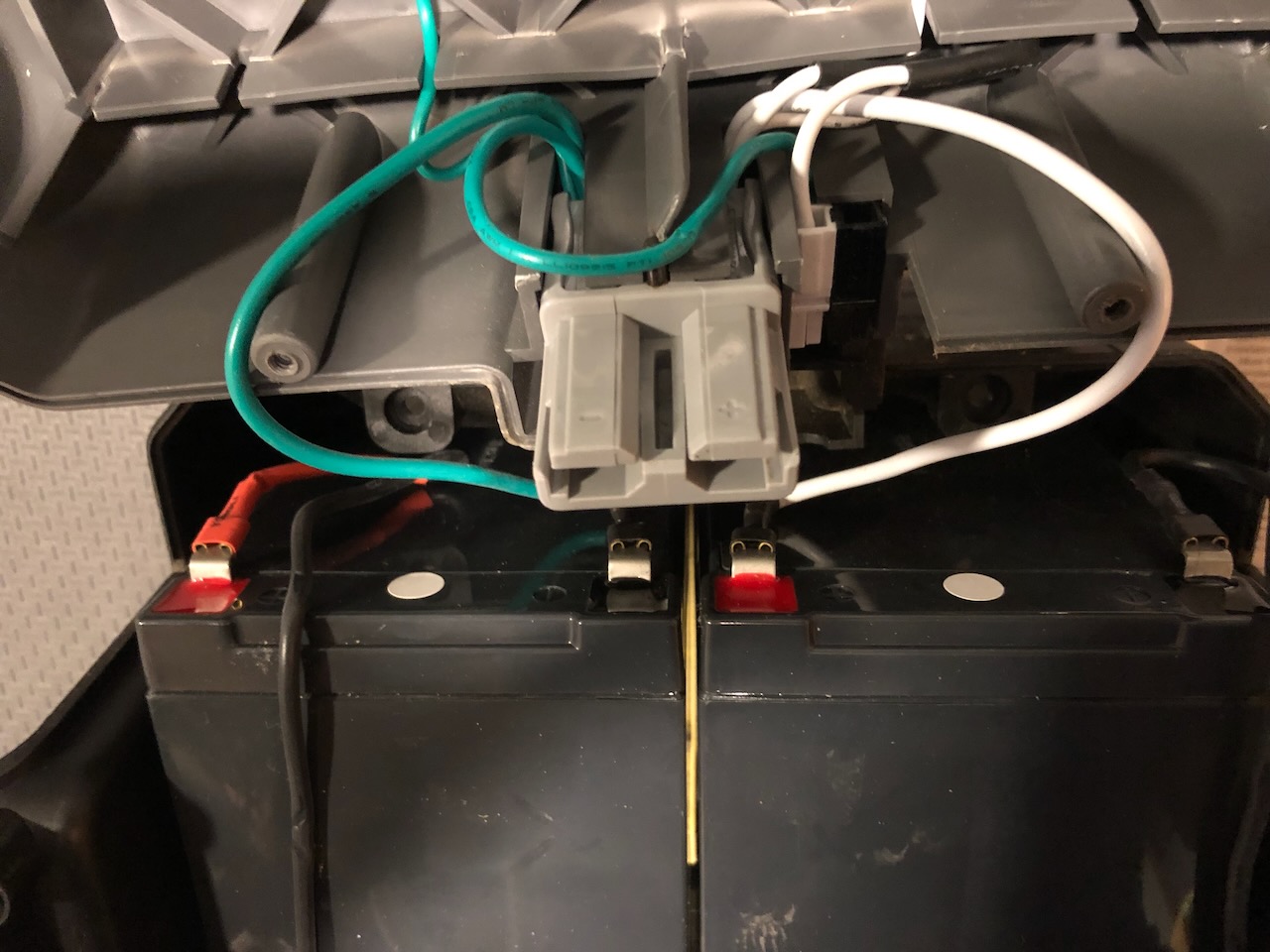 Next, I took a couple of shots to document carefully the wiring colors, where they
connect, and the orientations of each of the cells (i.e., where the red terminal goes).
Next, I took a couple of shots to document carefully the wiring colors, where they
connect, and the orientations of each of the cells (i.e., where the red terminal goes).
- Front cell: red terminal on the right, two black wires connecting routed from each side.
- Back 2 cells: red terminals on the left (looking down, remember this on the other side
so the cells have been rotated). Black wire comes around on the left and acquires a red
jacket, other black wire comes around on the right and stays black. Green and white
wires connect to the middle terminals, as shown.
- Somewhat harder to see: in the gray clip just above the cells, there’s a small metal rod that holds the clip in position. If you look at it sideways, it will fall out and roll obstinately under some inconveniently heavy object. Do not permit it to do that.
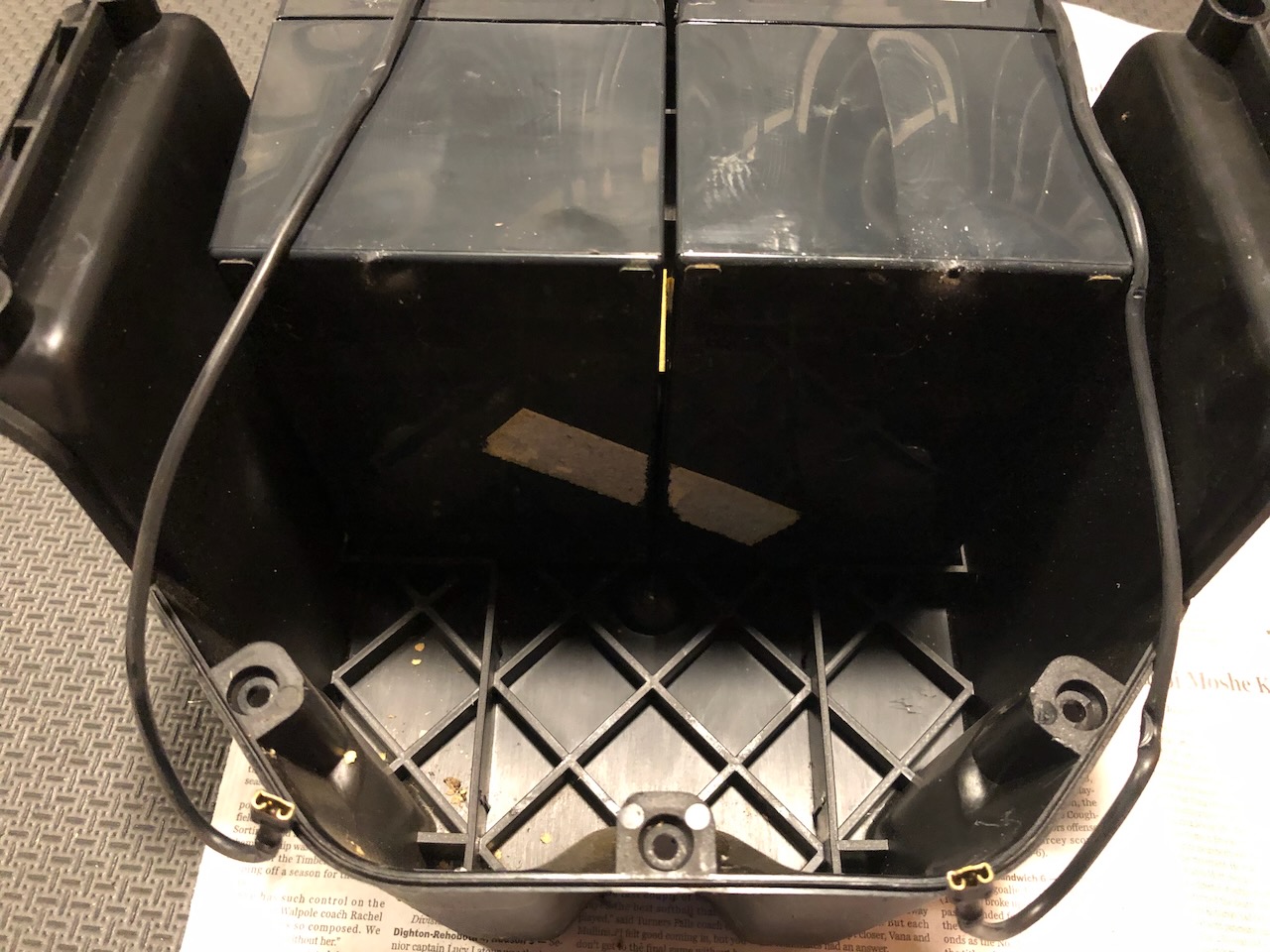 At that point, we’ve learned all we can learn about how to put it back together, so it’s
time to start taking stuff apart.
At that point, we’ve learned all we can learn about how to put it back together, so it’s
time to start taking stuff apart.
Here’s the view of the yawning chasm that gapes when you disconnect the wires from the front cell and prise it loose. Note the adhesive tape, annoyingly strong, that held it to the other batteries. A screwdriver may be required to pry them apart. Our replacement will not have that, but I think it’s more for shipping than for mowing.
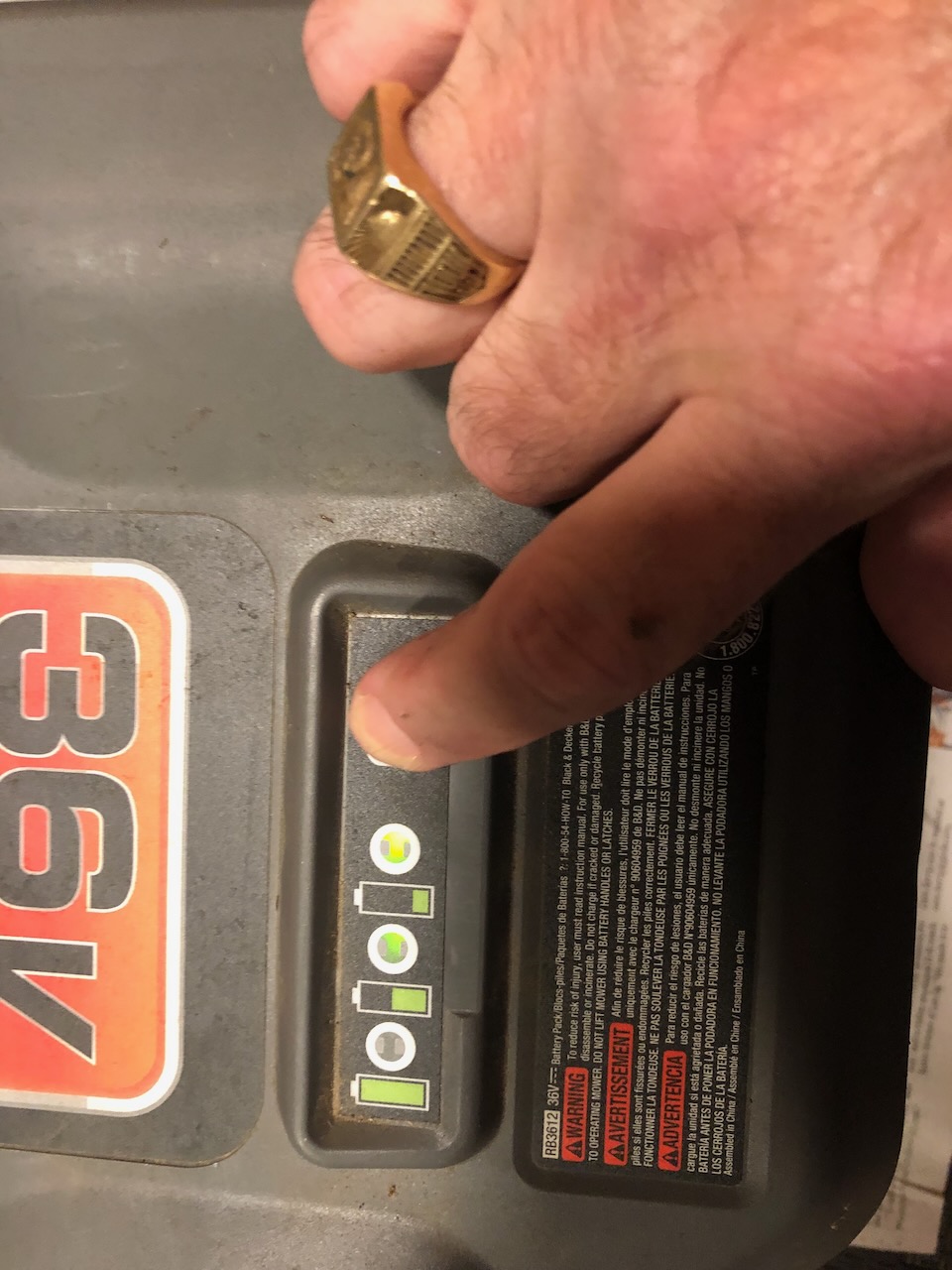 Next is the obvious: insert the new cells, carefully rewire them in exactly the same
way as the old ones, and close up the lid.
Next is the obvious: insert the new cells, carefully rewire them in exactly the same
way as the old ones, and close up the lid.
I did note that the lid wouldn’t quite close, and rather than just tighten down the screws by brute force, I discovered that one of the wires was being pinched. So after carefully pushing it back down into safer regions, I could tighten down the lid.
Here you can see at least partial success: pushing the test button on the lid shows 2 out of 3 LEDs lighting, indicating that there’s something like a functioning battery here. I hope that it’s 2 out of 3 only because the batteries were shipped in a not fully charged state, and not that the cells are defective or my wiring is inadequately full of resistances.
At that point I reinstalled the battery in the mower, and proceeded to try it out. That is, after all, the acid test (though the “acid” in this case was sealed inside the cells in the battery).
The Weekend Conclusion
The patient lived, and showed good appetite post-surgery by mowing tall, wet grass. Best I can ask of a 13 year old mower with its brave new little battery.
(Ceterum censeo, Trump incarcerandam esse.)
Notes & References
1: Weekend Editor, “My Brief But Spectacular Career as a Lawnmower Battery Surgeon”, Some Weekend Reading blog, 2022-Jun-24. ↩

Gestae Commentaria
Comments for this post are closed pending repair of the comment system, but the Email/Twitter/Mastodon icons at page-top always work.